Impact of Motivation on Employee Performance: Vodacom Tanzania Ltd
VerifiedAdded on 2023/02/02
|84
|18982
|24
Thesis and Dissertation
AI Summary
This dissertation, submitted to The Open University of Tanzania in 2014, investigates the impact of motivation on employee performance in goal attainment, using Vodacom Tanzania Limited as a case study. The study aims to identify the criteria companies use to motivate employees, examine the obstacles they face, and assess the impact of motivation on performance. Employing a case study design with a sample of 63 employees, the research utilizes questionnaires and interviews for data collection, analyzed using SPSS. The findings reveal the significance of a positive working environment as a key motivational criterion and employee turnover as a primary obstacle. The study concludes that various factors, including a positive work environment, recognition, rewards, and skill development, are crucial for employee motivation. The research recommends implementing motivational activities within the Human Resource Department to enhance employee performance and retention. The dissertation includes a comprehensive literature review, detailed methodology, and in-depth analysis of the findings, offering valuable insights into the dynamics of employee motivation within the Tanzanian context.
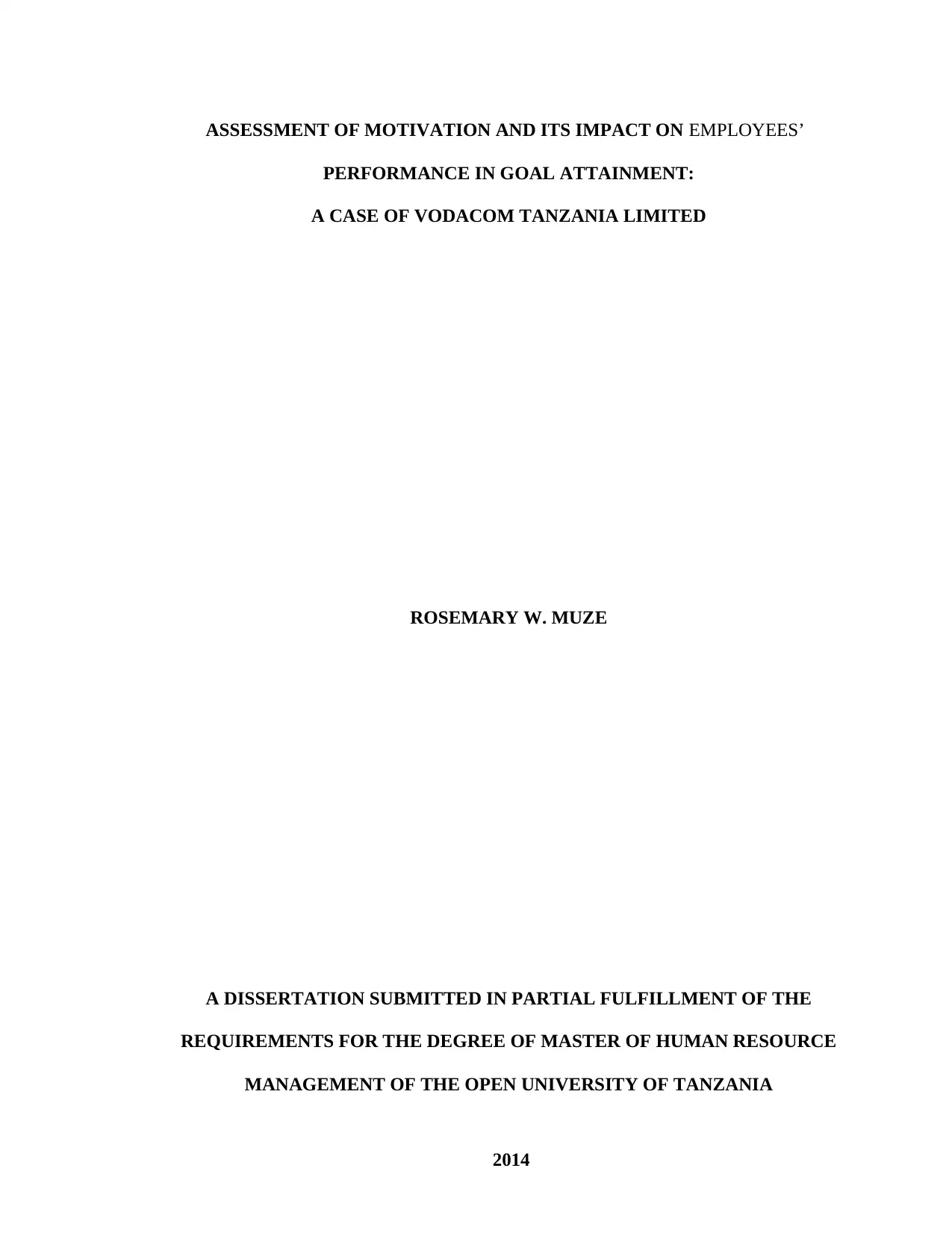
ASSESSMENT OF MOTIVATION AND ITS IMPACT ON EMPLOYEES’
PERFORMANCE IN GOAL ATTAINMENT:
A CASE OF VODACOM TANZANIA LIMITED
ROSEMARY W. MUZE
A DISSERTATION SUBMITTED IN PARTIAL FULFILLMENT OF THE
REQUIREMENTS FOR THE DEGREE OF MASTER OF HUMAN RESOURCE
MANAGEMENT OF THE OPEN UNIVERSITY OF TANZANIA
2014
PERFORMANCE IN GOAL ATTAINMENT:
A CASE OF VODACOM TANZANIA LIMITED
ROSEMARY W. MUZE
A DISSERTATION SUBMITTED IN PARTIAL FULFILLMENT OF THE
REQUIREMENTS FOR THE DEGREE OF MASTER OF HUMAN RESOURCE
MANAGEMENT OF THE OPEN UNIVERSITY OF TANZANIA
2014
Paraphrase This Document
Need a fresh take? Get an instant paraphrase of this document with our AI Paraphraser
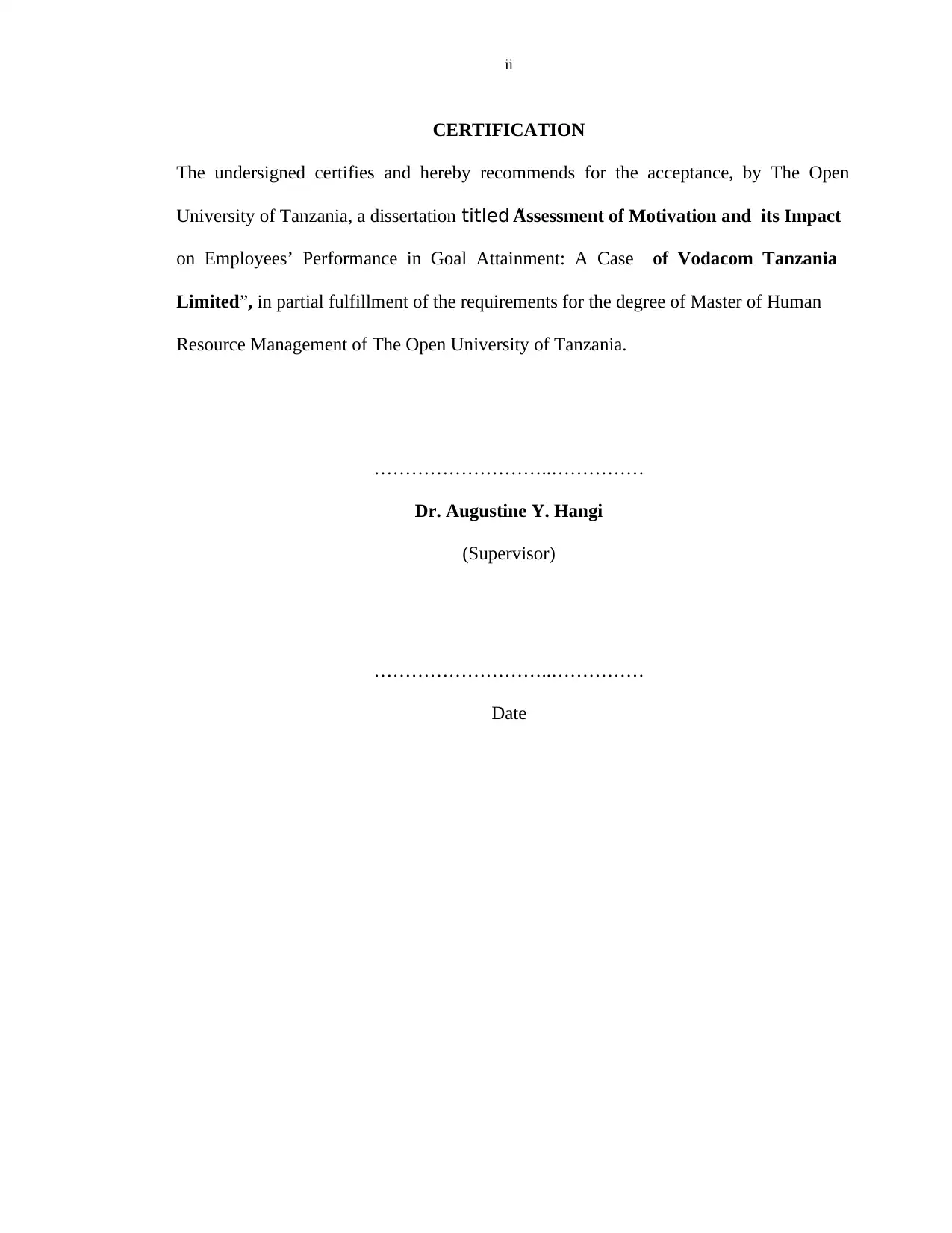
ii
CERTIFICATION
The undersigned certifies and hereby recommends for the acceptance, by The Open
University of Tanzania, a dissertation titled “Assessment of Motivation and its Impact
on Employees’ Performance in Goal Attainment: A Case of Vodacom Tanzania
Limited”, in partial fulfillment of the requirements for the degree of Master of Human
Resource Management of The Open University of Tanzania.
………………………..……………
Dr. Augustine Y. Hangi
(Supervisor)
………………………..……………
Date
CERTIFICATION
The undersigned certifies and hereby recommends for the acceptance, by The Open
University of Tanzania, a dissertation titled “Assessment of Motivation and its Impact
on Employees’ Performance in Goal Attainment: A Case of Vodacom Tanzania
Limited”, in partial fulfillment of the requirements for the degree of Master of Human
Resource Management of The Open University of Tanzania.
………………………..……………
Dr. Augustine Y. Hangi
(Supervisor)
………………………..……………
Date
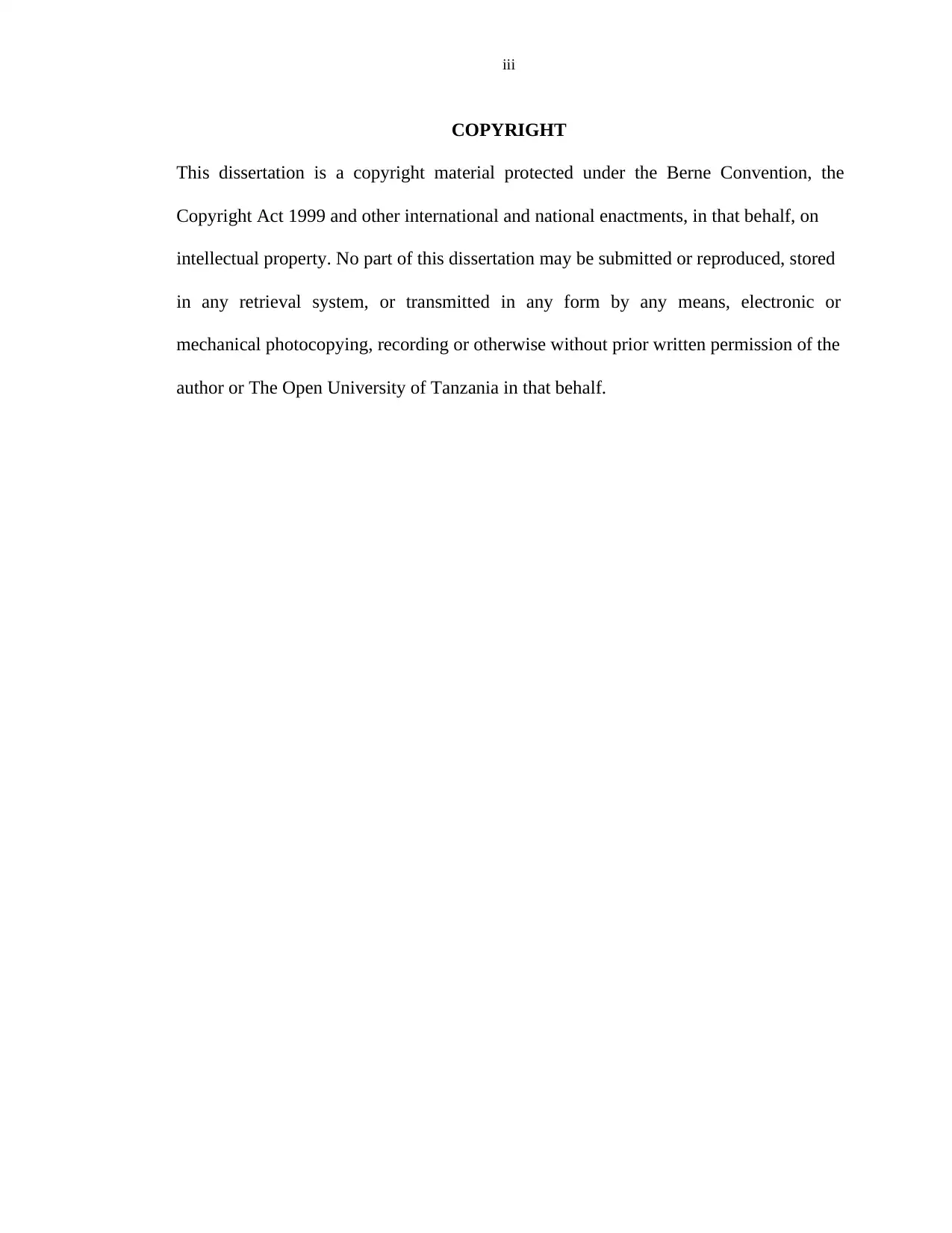
iii
COPYRIGHT
This dissertation is a copyright material protected under the Berne Convention, the
Copyright Act 1999 and other international and national enactments, in that behalf, on
intellectual property. No part of this dissertation may be submitted or reproduced, stored
in any retrieval system, or transmitted in any form by any means, electronic or
mechanical photocopying, recording or otherwise without prior written permission of the
author or The Open University of Tanzania in that behalf.
COPYRIGHT
This dissertation is a copyright material protected under the Berne Convention, the
Copyright Act 1999 and other international and national enactments, in that behalf, on
intellectual property. No part of this dissertation may be submitted or reproduced, stored
in any retrieval system, or transmitted in any form by any means, electronic or
mechanical photocopying, recording or otherwise without prior written permission of the
author or The Open University of Tanzania in that behalf.
⊘ This is a preview!⊘
Do you want full access?
Subscribe today to unlock all pages.

Trusted by 1+ million students worldwide
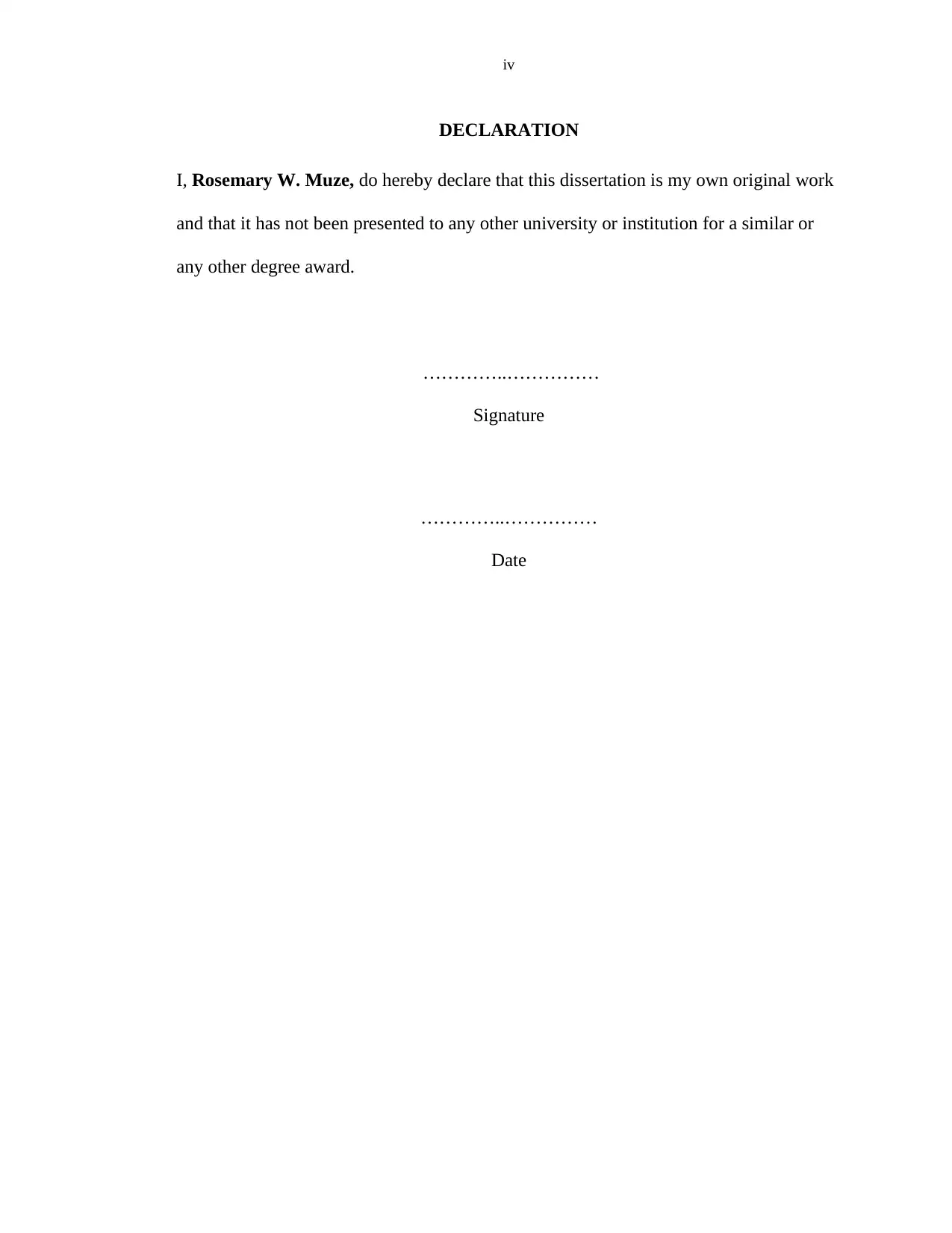
iv
DECLARATION
I, Rosemary W. Muze, do hereby declare that this dissertation is my own original work
and that it has not been presented to any other university or institution for a similar or
any other degree award.
…………..……………
Signature
…………..……………
Date
DECLARATION
I, Rosemary W. Muze, do hereby declare that this dissertation is my own original work
and that it has not been presented to any other university or institution for a similar or
any other degree award.
…………..……………
Signature
…………..……………
Date
Paraphrase This Document
Need a fresh take? Get an instant paraphrase of this document with our AI Paraphraser
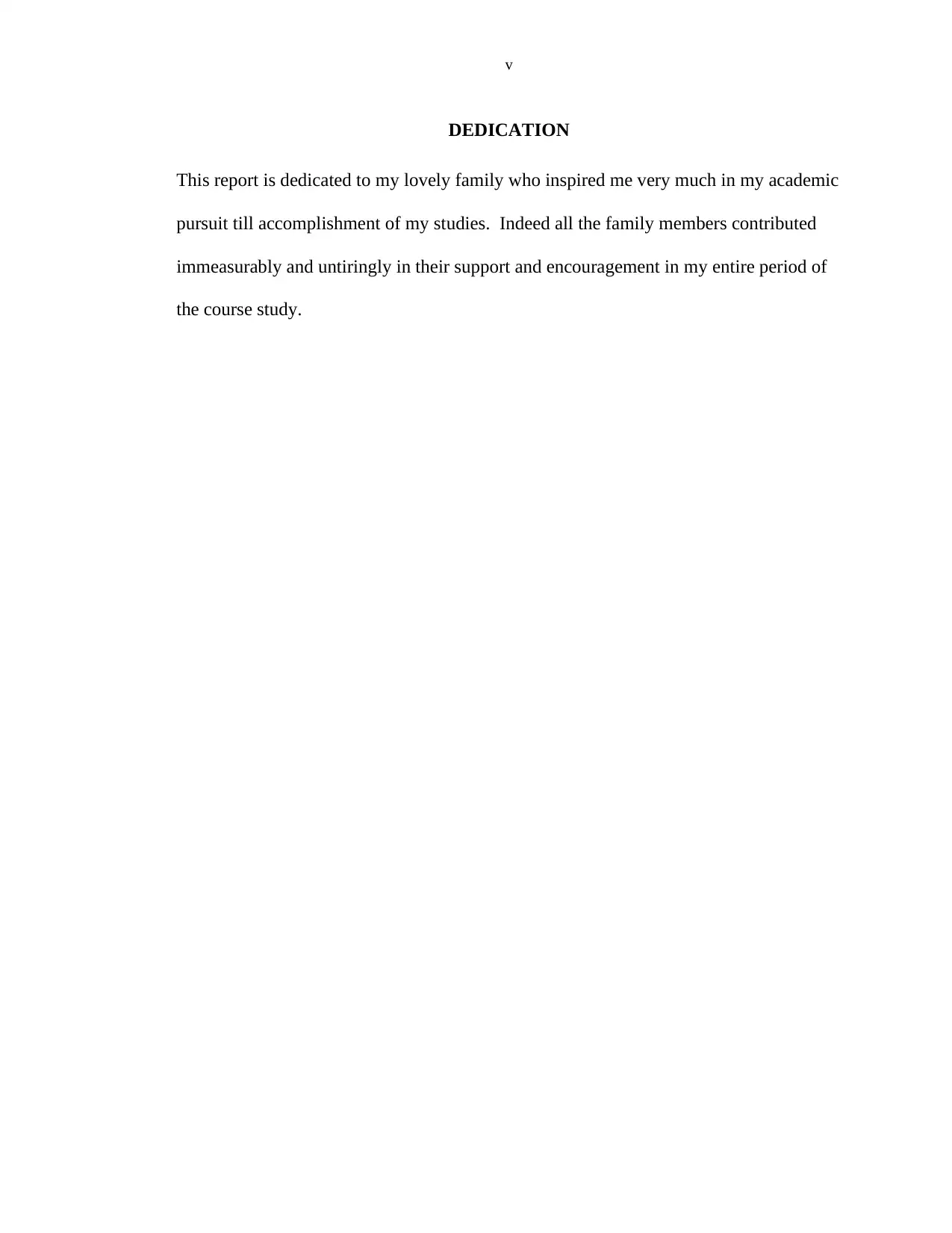
v
DEDICATION
This report is dedicated to my lovely family who inspired me very much in my academic
pursuit till accomplishment of my studies. Indeed all the family members contributed
immeasurably and untiringly in their support and encouragement in my entire period of
the course study.
DEDICATION
This report is dedicated to my lovely family who inspired me very much in my academic
pursuit till accomplishment of my studies. Indeed all the family members contributed
immeasurably and untiringly in their support and encouragement in my entire period of
the course study.
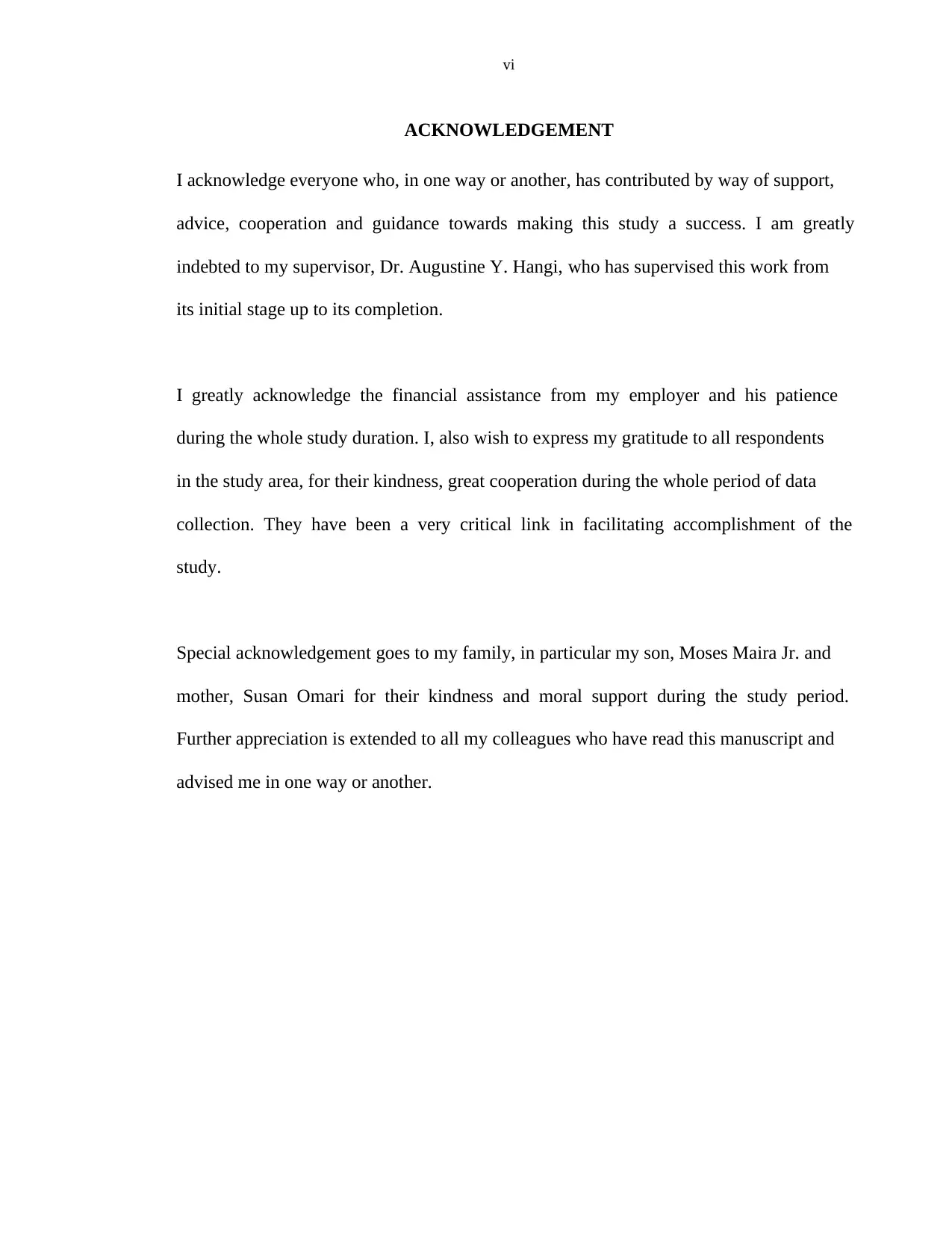
vi
ACKNOWLEDGEMENT
I acknowledge everyone who, in one way or another, has contributed by way of support,
advice, cooperation and guidance towards making this study a success. I am greatly
indebted to my supervisor, Dr. Augustine Y. Hangi, who has supervised this work from
its initial stage up to its completion.
I greatly acknowledge the financial assistance from my employer and his patience
during the whole study duration. I, also wish to express my gratitude to all respondents
in the study area, for their kindness, great cooperation during the whole period of data
collection. They have been a very critical link in facilitating accomplishment of the
study.
Special acknowledgement goes to my family, in particular my son, Moses Maira Jr. and
mother, Susan Omari for their kindness and moral support during the study period.
Further appreciation is extended to all my colleagues who have read this manuscript and
advised me in one way or another.
ACKNOWLEDGEMENT
I acknowledge everyone who, in one way or another, has contributed by way of support,
advice, cooperation and guidance towards making this study a success. I am greatly
indebted to my supervisor, Dr. Augustine Y. Hangi, who has supervised this work from
its initial stage up to its completion.
I greatly acknowledge the financial assistance from my employer and his patience
during the whole study duration. I, also wish to express my gratitude to all respondents
in the study area, for their kindness, great cooperation during the whole period of data
collection. They have been a very critical link in facilitating accomplishment of the
study.
Special acknowledgement goes to my family, in particular my son, Moses Maira Jr. and
mother, Susan Omari for their kindness and moral support during the study period.
Further appreciation is extended to all my colleagues who have read this manuscript and
advised me in one way or another.
⊘ This is a preview!⊘
Do you want full access?
Subscribe today to unlock all pages.

Trusted by 1+ million students worldwide
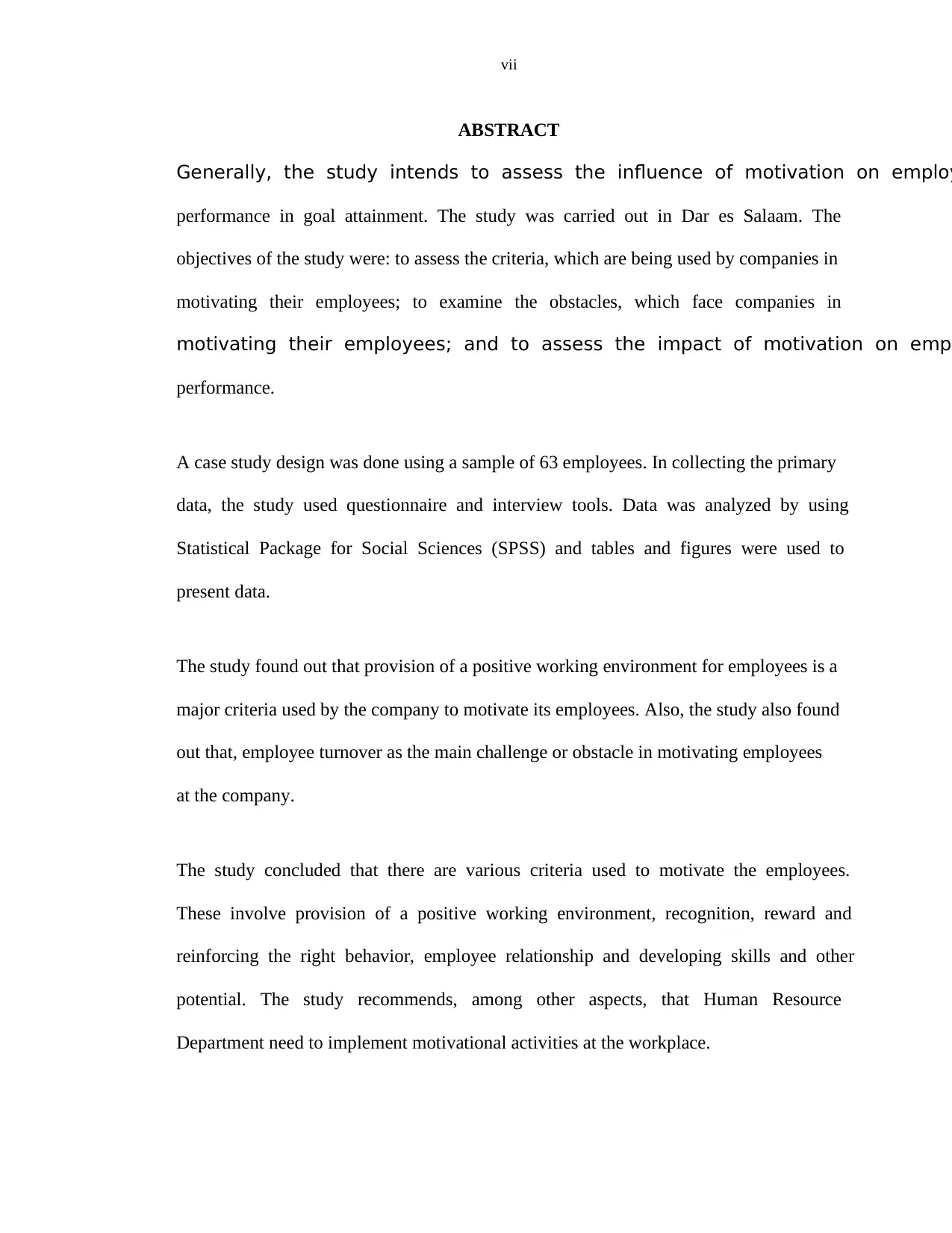
vii
ABSTRACT
Generally, the study intends to assess the influence of motivation on employ
performance in goal attainment. The study was carried out in Dar es Salaam. The
objectives of the study were: to assess the criteria, which are being used by companies in
motivating their employees; to examine the obstacles, which face companies in
motivating their employees; and to assess the impact of motivation on empl
performance.
A case study design was done using a sample of 63 employees. In collecting the primary
data, the study used questionnaire and interview tools. Data was analyzed by using
Statistical Package for Social Sciences (SPSS) and tables and figures were used to
present data.
The study found out that provision of a positive working environment for employees is a
major criteria used by the company to motivate its employees. Also, the study also found
out that, employee turnover as the main challenge or obstacle in motivating employees
at the company.
The study concluded that there are various criteria used to motivate the employees.
These involve provision of a positive working environment, recognition, reward and
reinforcing the right behavior, employee relationship and developing skills and other
potential. The study recommends, among other aspects, that Human Resource
Department need to implement motivational activities at the workplace.
ABSTRACT
Generally, the study intends to assess the influence of motivation on employ
performance in goal attainment. The study was carried out in Dar es Salaam. The
objectives of the study were: to assess the criteria, which are being used by companies in
motivating their employees; to examine the obstacles, which face companies in
motivating their employees; and to assess the impact of motivation on empl
performance.
A case study design was done using a sample of 63 employees. In collecting the primary
data, the study used questionnaire and interview tools. Data was analyzed by using
Statistical Package for Social Sciences (SPSS) and tables and figures were used to
present data.
The study found out that provision of a positive working environment for employees is a
major criteria used by the company to motivate its employees. Also, the study also found
out that, employee turnover as the main challenge or obstacle in motivating employees
at the company.
The study concluded that there are various criteria used to motivate the employees.
These involve provision of a positive working environment, recognition, reward and
reinforcing the right behavior, employee relationship and developing skills and other
potential. The study recommends, among other aspects, that Human Resource
Department need to implement motivational activities at the workplace.
Paraphrase This Document
Need a fresh take? Get an instant paraphrase of this document with our AI Paraphraser
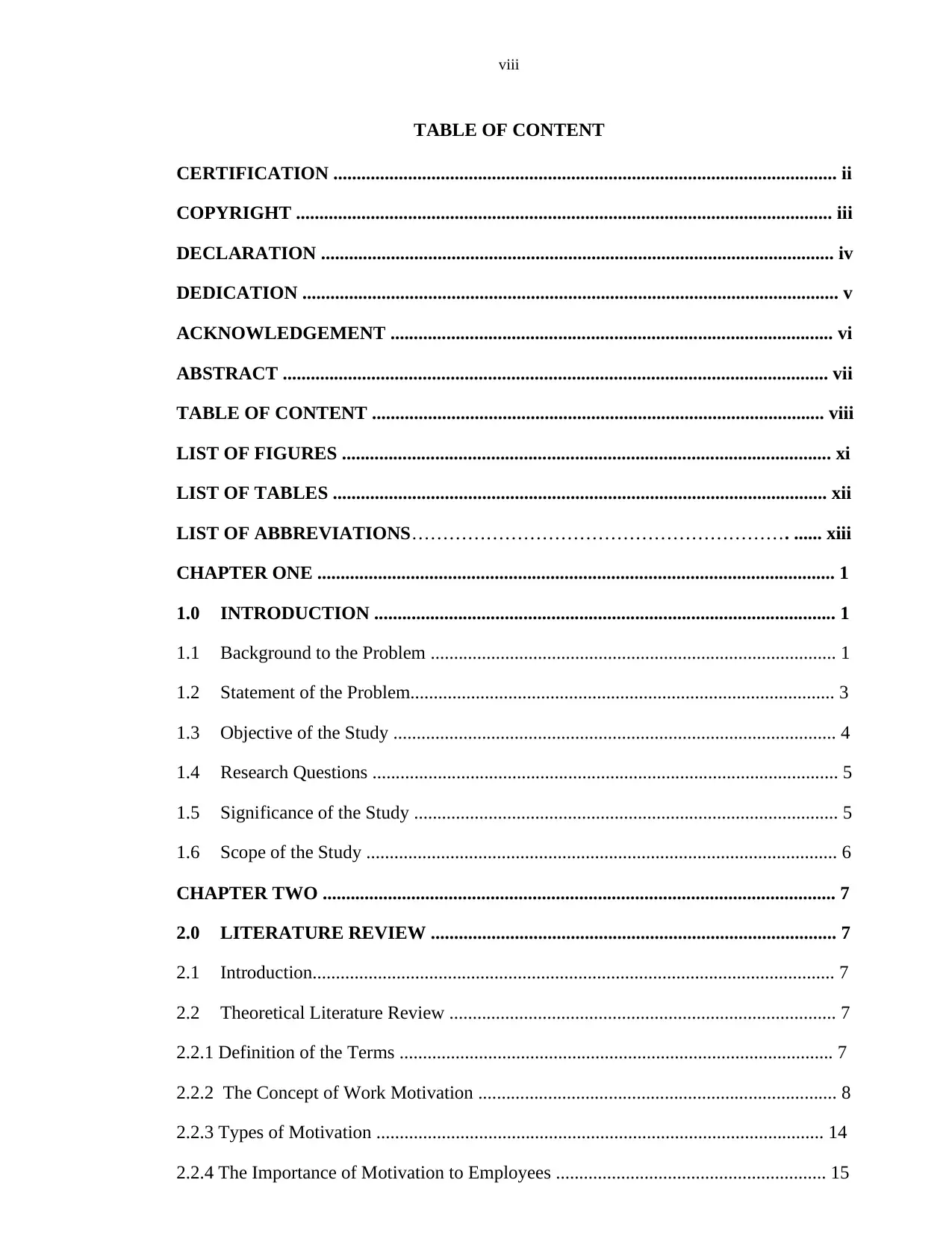
viii
TABLE OF CONTENT
CERTIFICATION ............................................................................................................ ii
COPYRIGHT ................................................................................................................... iii
DECLARATION .............................................................................................................. iv
DEDICATION ................................................................................................................... v
ACKNOWLEDGEMENT ............................................................................................... vi
ABSTRACT ..................................................................................................................... vii
TABLE OF CONTENT ................................................................................................. viii
LIST OF FIGURES ......................................................................................................... xi
LIST OF TABLES .......................................................................................................... xii
LIST OF ABBREVIATIONS……………………………………………………. ...... xiii
CHAPTER ONE ............................................................................................................... 1
1.0 INTRODUCTION ................................................................................................... 1
1.1 Background to the Problem ....................................................................................... 1
1.2 Statement of the Problem........................................................................................... 3
1.3 Objective of the Study ............................................................................................... 4
1.4 Research Questions .................................................................................................... 5
1.5 Significance of the Study ........................................................................................... 5
1.6 Scope of the Study ..................................................................................................... 6
CHAPTER TWO .............................................................................................................. 7
2.0 LITERATURE REVIEW ....................................................................................... 7
2.1 Introduction................................................................................................................ 7
2.2 Theoretical Literature Review ................................................................................... 7
2.2.1 Definition of the Terms ............................................................................................. 7
2.2.2 The Concept of Work Motivation ............................................................................. 8
2.2.3 Types of Motivation ................................................................................................ 14
2.2.4 The Importance of Motivation to Employees .......................................................... 15
TABLE OF CONTENT
CERTIFICATION ............................................................................................................ ii
COPYRIGHT ................................................................................................................... iii
DECLARATION .............................................................................................................. iv
DEDICATION ................................................................................................................... v
ACKNOWLEDGEMENT ............................................................................................... vi
ABSTRACT ..................................................................................................................... vii
TABLE OF CONTENT ................................................................................................. viii
LIST OF FIGURES ......................................................................................................... xi
LIST OF TABLES .......................................................................................................... xii
LIST OF ABBREVIATIONS……………………………………………………. ...... xiii
CHAPTER ONE ............................................................................................................... 1
1.0 INTRODUCTION ................................................................................................... 1
1.1 Background to the Problem ....................................................................................... 1
1.2 Statement of the Problem........................................................................................... 3
1.3 Objective of the Study ............................................................................................... 4
1.4 Research Questions .................................................................................................... 5
1.5 Significance of the Study ........................................................................................... 5
1.6 Scope of the Study ..................................................................................................... 6
CHAPTER TWO .............................................................................................................. 7
2.0 LITERATURE REVIEW ....................................................................................... 7
2.1 Introduction................................................................................................................ 7
2.2 Theoretical Literature Review ................................................................................... 7
2.2.1 Definition of the Terms ............................................................................................. 7
2.2.2 The Concept of Work Motivation ............................................................................. 8
2.2.3 Types of Motivation ................................................................................................ 14
2.2.4 The Importance of Motivation to Employees .......................................................... 15
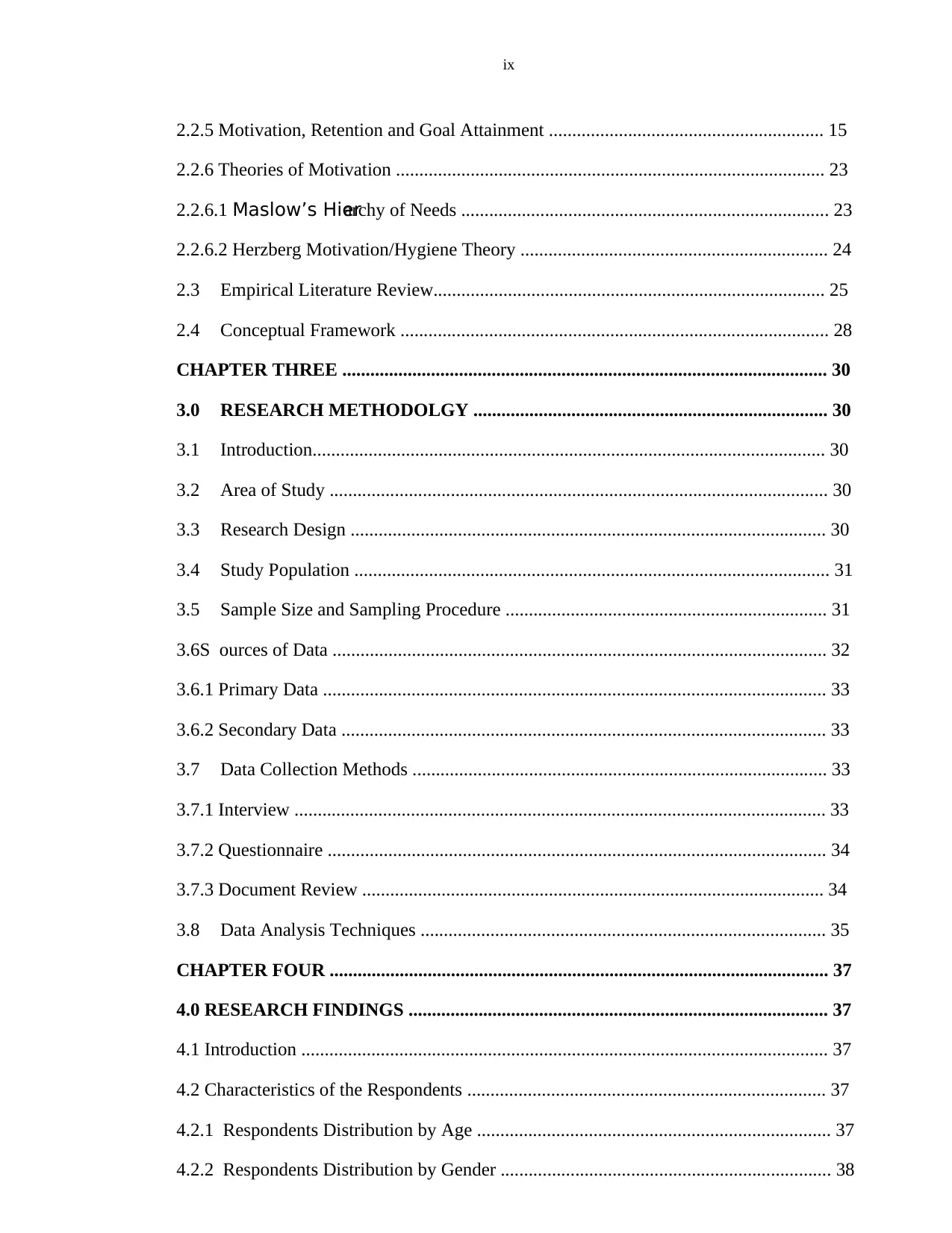
ix
2.2.5 Motivation, Retention and Goal Attainment ........................................................... 15
2.2.6 Theories of Motivation ............................................................................................ 23
2.2.6.1 Maslow’s Hierarchy of Needs ............................................................................... 23
2.2.6.2 Herzberg Motivation/Hygiene Theory .................................................................. 24
2.3 Empirical Literature Review.................................................................................... 25
2.4 Conceptual Framework ............................................................................................ 28
CHAPTER THREE ........................................................................................................ 30
3.0 RESEARCH METHODOLGY ............................................................................ 30
3.1 Introduction.............................................................................................................. 30
3.2 Area of Study ........................................................................................................... 30
3.3 Research Design ...................................................................................................... 30
3.4 Study Population ...................................................................................................... 31
3.5 Sample Size and Sampling Procedure ..................................................................... 31
3.6S ources of Data .......................................................................................................... 32
3.6.1 Primary Data ............................................................................................................ 33
3.6.2 Secondary Data ........................................................................................................ 33
3.7 Data Collection Methods ......................................................................................... 33
3.7.1 Interview .................................................................................................................. 33
3.7.2 Questionnaire ........................................................................................................... 34
3.7.3 Document Review ................................................................................................... 34
3.8 Data Analysis Techniques ....................................................................................... 35
CHAPTER FOUR ........................................................................................................... 37
4.0 RESEARCH FINDINGS .......................................................................................... 37
4.1 Introduction ................................................................................................................. 37
4.2 Characteristics of the Respondents ............................................................................. 37
4.2.1 Respondents Distribution by Age ............................................................................ 37
4.2.2 Respondents Distribution by Gender ....................................................................... 38
2.2.5 Motivation, Retention and Goal Attainment ........................................................... 15
2.2.6 Theories of Motivation ............................................................................................ 23
2.2.6.1 Maslow’s Hierarchy of Needs ............................................................................... 23
2.2.6.2 Herzberg Motivation/Hygiene Theory .................................................................. 24
2.3 Empirical Literature Review.................................................................................... 25
2.4 Conceptual Framework ............................................................................................ 28
CHAPTER THREE ........................................................................................................ 30
3.0 RESEARCH METHODOLGY ............................................................................ 30
3.1 Introduction.............................................................................................................. 30
3.2 Area of Study ........................................................................................................... 30
3.3 Research Design ...................................................................................................... 30
3.4 Study Population ...................................................................................................... 31
3.5 Sample Size and Sampling Procedure ..................................................................... 31
3.6S ources of Data .......................................................................................................... 32
3.6.1 Primary Data ............................................................................................................ 33
3.6.2 Secondary Data ........................................................................................................ 33
3.7 Data Collection Methods ......................................................................................... 33
3.7.1 Interview .................................................................................................................. 33
3.7.2 Questionnaire ........................................................................................................... 34
3.7.3 Document Review ................................................................................................... 34
3.8 Data Analysis Techniques ....................................................................................... 35
CHAPTER FOUR ........................................................................................................... 37
4.0 RESEARCH FINDINGS .......................................................................................... 37
4.1 Introduction ................................................................................................................. 37
4.2 Characteristics of the Respondents ............................................................................. 37
4.2.1 Respondents Distribution by Age ............................................................................ 37
4.2.2 Respondents Distribution by Gender ....................................................................... 38
⊘ This is a preview!⊘
Do you want full access?
Subscribe today to unlock all pages.

Trusted by 1+ million students worldwide
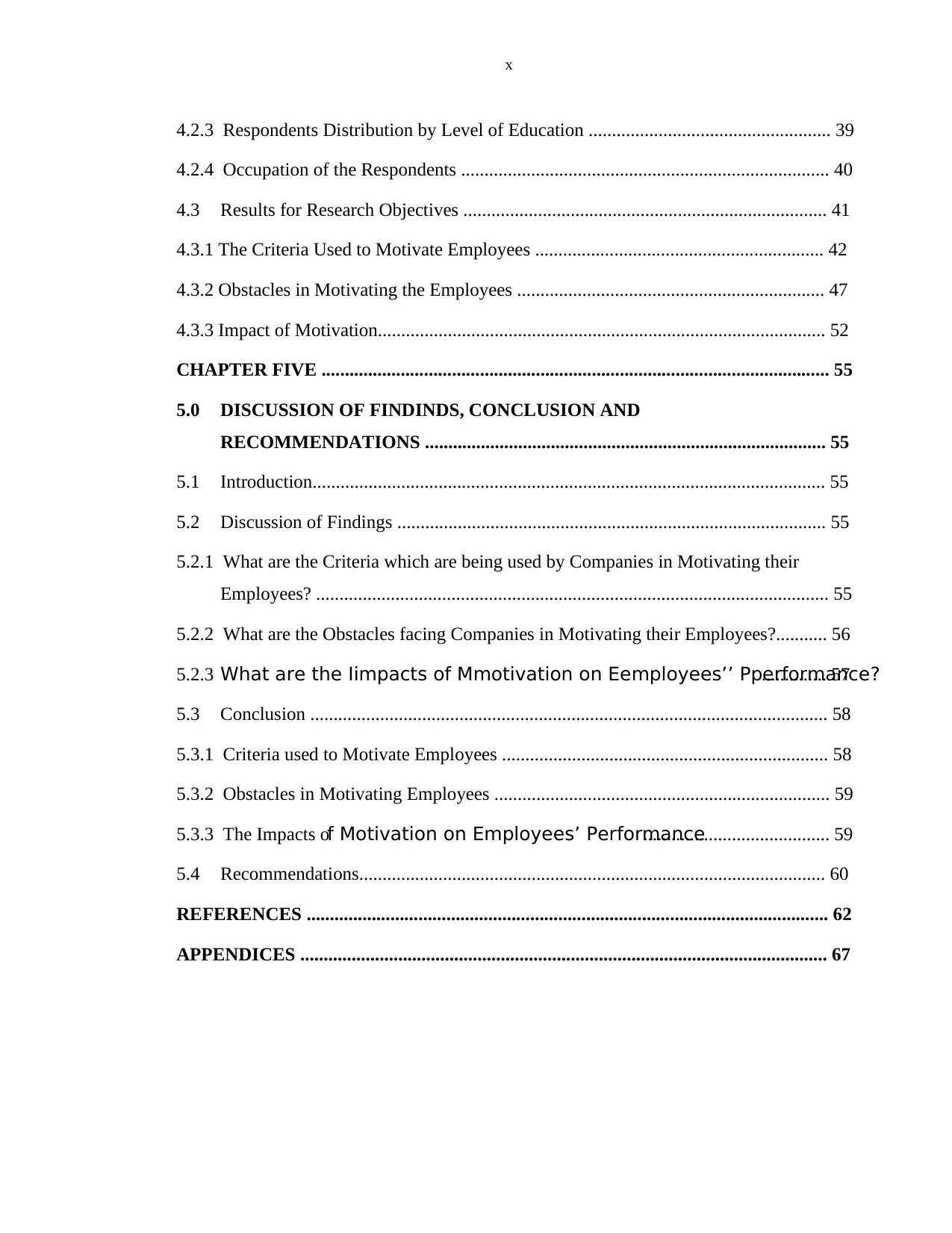
x
4.2.3 Respondents Distribution by Level of Education .................................................... 39
4.2.4 Occupation of the Respondents ............................................................................... 40
4.3 Results for Research Objectives .............................................................................. 41
4.3.1 The Criteria Used to Motivate Employees .............................................................. 42
4.3.2 Obstacles in Motivating the Employees .................................................................. 47
4.3.3 Impact of Motivation................................................................................................ 52
CHAPTER FIVE ............................................................................................................. 55
5.0 DISCUSSION OF FINDINDS, CONCLUSION AND
RECOMMENDATIONS ...................................................................................... 55
5.1 Introduction.............................................................................................................. 55
5.2 Discussion of Findings ............................................................................................ 55
5.2.1 What are the Criteria which are being used by Companies in Motivating their
Employees? .............................................................................................................. 55
5.2.2 What are the Obstacles facing Companies in Motivating their Employees?........... 56
5.2.3 What are the Iimpacts of Mmotivation on Eemployees’’ Pperformance?.............. 57
5.3 Conclusion ............................................................................................................... 58
5.3.1 Criteria used to Motivate Employees ...................................................................... 58
5.3.2 Obstacles in Motivating Employees ........................................................................ 59
5.3.3 The Impacts of Motivation on Employees’ Performance........................................ 59
5.4 Recommendations.................................................................................................... 60
REFERENCES ................................................................................................................ 62
APPENDICES ................................................................................................................. 67
4.2.3 Respondents Distribution by Level of Education .................................................... 39
4.2.4 Occupation of the Respondents ............................................................................... 40
4.3 Results for Research Objectives .............................................................................. 41
4.3.1 The Criteria Used to Motivate Employees .............................................................. 42
4.3.2 Obstacles in Motivating the Employees .................................................................. 47
4.3.3 Impact of Motivation................................................................................................ 52
CHAPTER FIVE ............................................................................................................. 55
5.0 DISCUSSION OF FINDINDS, CONCLUSION AND
RECOMMENDATIONS ...................................................................................... 55
5.1 Introduction.............................................................................................................. 55
5.2 Discussion of Findings ............................................................................................ 55
5.2.1 What are the Criteria which are being used by Companies in Motivating their
Employees? .............................................................................................................. 55
5.2.2 What are the Obstacles facing Companies in Motivating their Employees?........... 56
5.2.3 What are the Iimpacts of Mmotivation on Eemployees’’ Pperformance?.............. 57
5.3 Conclusion ............................................................................................................... 58
5.3.1 Criteria used to Motivate Employees ...................................................................... 58
5.3.2 Obstacles in Motivating Employees ........................................................................ 59
5.3.3 The Impacts of Motivation on Employees’ Performance........................................ 59
5.4 Recommendations.................................................................................................... 60
REFERENCES ................................................................................................................ 62
APPENDICES ................................................................................................................. 67
Paraphrase This Document
Need a fresh take? Get an instant paraphrase of this document with our AI Paraphraser
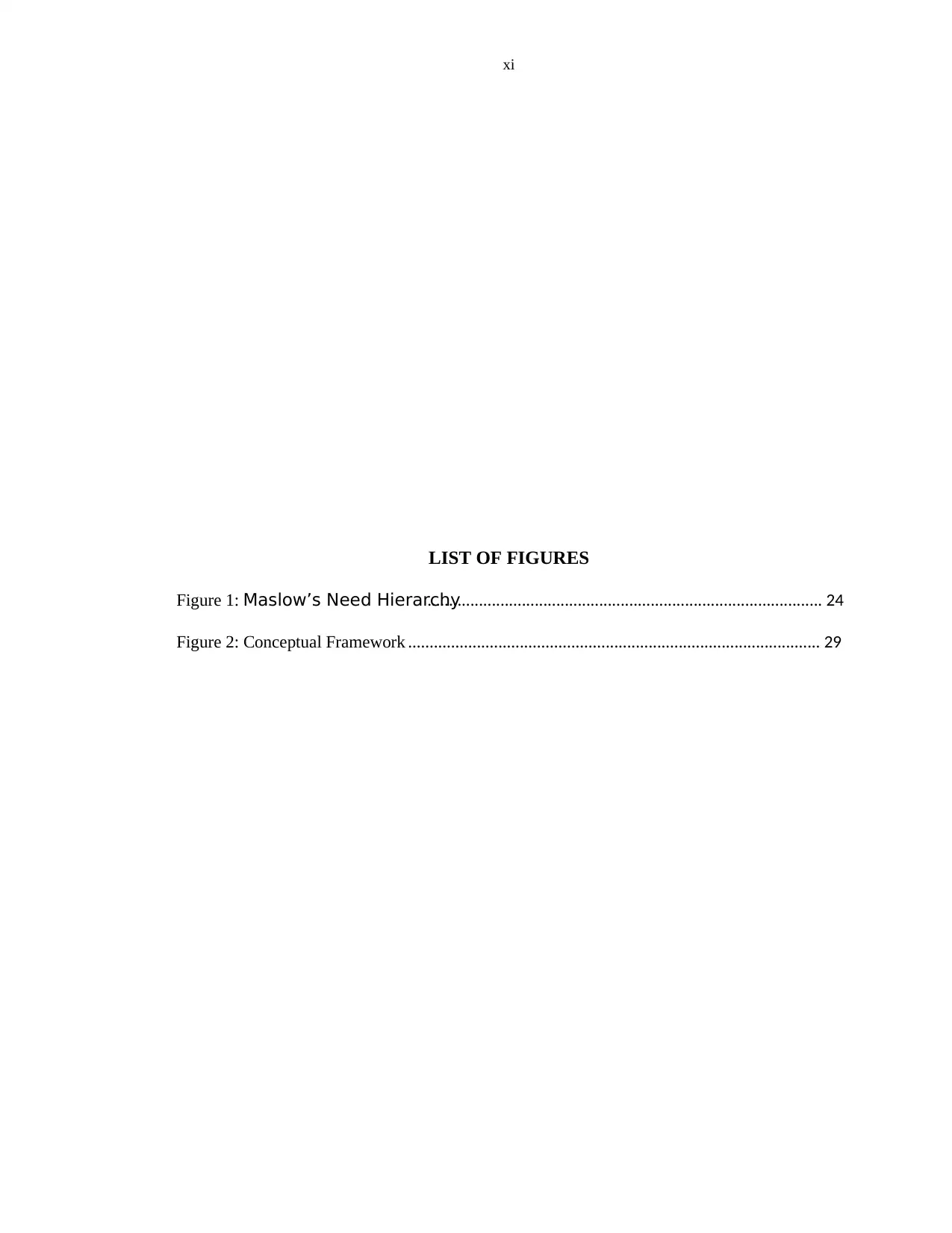
xi
LIST OF FIGURES
Figure 1: Maslow’s Need Hierarchy............................................................................................ 24
Figure 2: Conceptual Framework ................................................................................................ 29
LIST OF FIGURES
Figure 1: Maslow’s Need Hierarchy............................................................................................ 24
Figure 2: Conceptual Framework ................................................................................................ 29
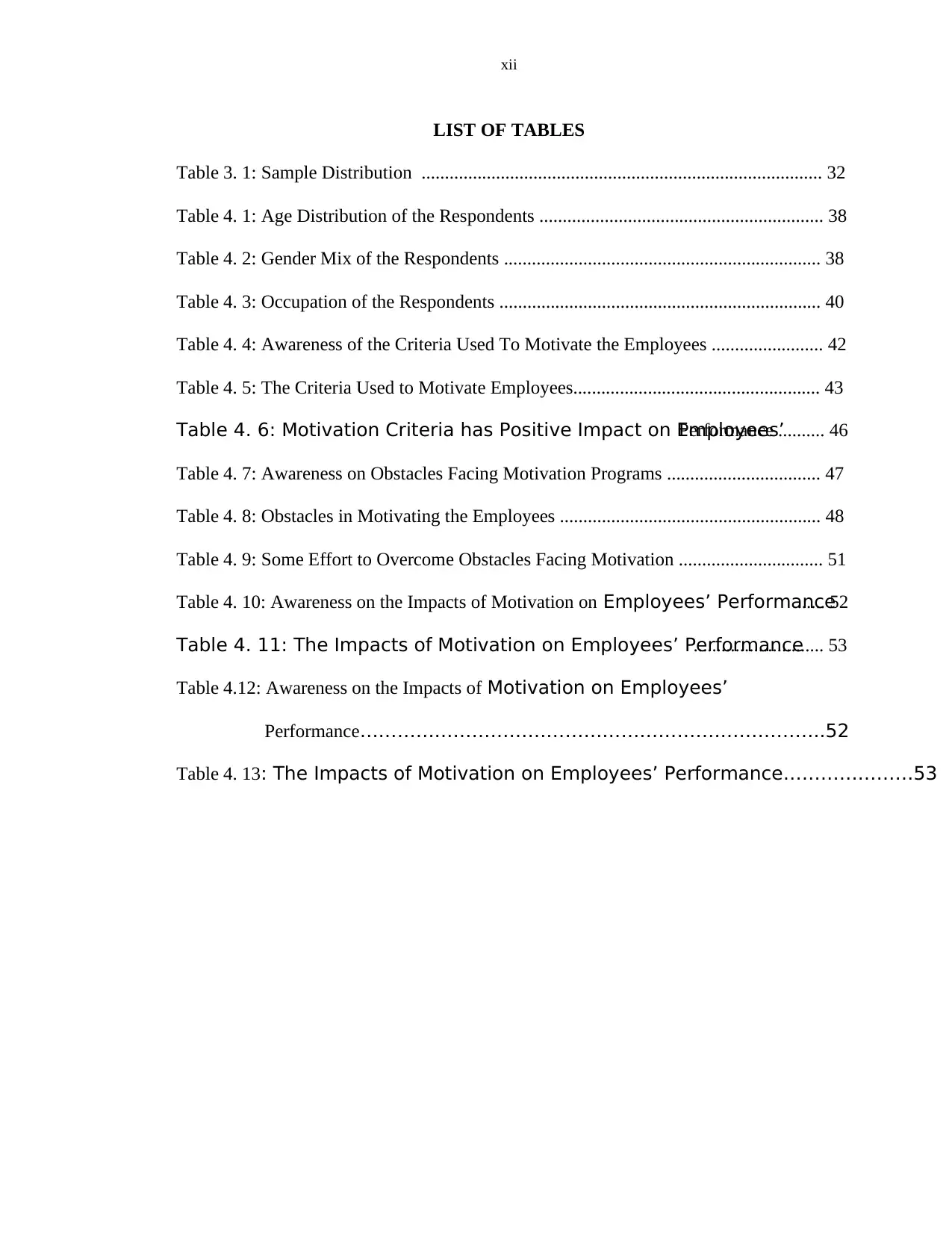
xii
LIST OF TABLES
Table 3. 1: Sample Distribution ...................................................................................... 32
Table 4. 1: Age Distribution of the Respondents ............................................................. 38
Table 4. 2: Gender Mix of the Respondents .................................................................... 38
Table 4. 3: Occupation of the Respondents ..................................................................... 40
Table 4. 4: Awareness of the Criteria Used To Motivate the Employees ........................ 42
Table 4. 5: The Criteria Used to Motivate Employees..................................................... 43
Table 4. 6: Motivation Criteria has Positive Impact on Employees’Performance .......... 46
Table 4. 7: Awareness on Obstacles Facing Motivation Programs ................................. 47
Table 4. 8: Obstacles in Motivating the Employees ........................................................ 48
Table 4. 9: Some Effort to Overcome Obstacles Facing Motivation ............................... 51
Table 4. 10: Awareness on the Impacts of Motivation on Employees’ Performance...... 52
Table 4. 11: The Impacts of Motivation on Employees’ Performance............................ 53
Table 4.12: Awareness on the Impacts of Motivation on Employees’
Performance…………………………………………….…………………..52
Table 4. 13: The Impacts of Motivation on Employees’ Performance…………………53
LIST OF TABLES
Table 3. 1: Sample Distribution ...................................................................................... 32
Table 4. 1: Age Distribution of the Respondents ............................................................. 38
Table 4. 2: Gender Mix of the Respondents .................................................................... 38
Table 4. 3: Occupation of the Respondents ..................................................................... 40
Table 4. 4: Awareness of the Criteria Used To Motivate the Employees ........................ 42
Table 4. 5: The Criteria Used to Motivate Employees..................................................... 43
Table 4. 6: Motivation Criteria has Positive Impact on Employees’Performance .......... 46
Table 4. 7: Awareness on Obstacles Facing Motivation Programs ................................. 47
Table 4. 8: Obstacles in Motivating the Employees ........................................................ 48
Table 4. 9: Some Effort to Overcome Obstacles Facing Motivation ............................... 51
Table 4. 10: Awareness on the Impacts of Motivation on Employees’ Performance...... 52
Table 4. 11: The Impacts of Motivation on Employees’ Performance............................ 53
Table 4.12: Awareness on the Impacts of Motivation on Employees’
Performance…………………………………………….…………………..52
Table 4. 13: The Impacts of Motivation on Employees’ Performance…………………53
⊘ This is a preview!⊘
Do you want full access?
Subscribe today to unlock all pages.

Trusted by 1+ million students worldwide
1 out of 84
Related Documents
Your All-in-One AI-Powered Toolkit for Academic Success.
+13062052269
info@desklib.com
Available 24*7 on WhatsApp / Email
![[object Object]](/_next/static/media/star-bottom.7253800d.svg)
Unlock your academic potential
Copyright © 2020–2025 A2Z Services. All Rights Reserved. Developed and managed by ZUCOL.





